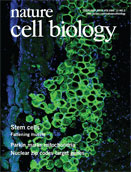
科学家们发现了一个在发育最初阶段发挥关键作用的基因家族,在此阶段,胚胎已可辨别身体的左右侧,并开始确定器官在体内的安放位置。在小鼠身上的此项发现能使人们更好地理解人类的某些先天缺陷是如何发生的。此项研究成果发表在1月24日出版的《自然细胞生物学》杂志网络版上。
此项研究建立在左右对称破缺的胚胎发育机理之上。日本大阪大学遗传学家滨田宏博士及其同事的研究指出,位于胚胎节点区域内的细胞表面的纤毛会在胚胎外形成左向流动,反过来让胚胎知道哪边是左边。其原因是纤毛朝向节点细胞的背部,且向胚胎尾部倾斜。
这个独特的位置,与纤毛的顺时针运动相结合形成了左向流动,随之胚胎的左右对称被打破。据研究,如果没有定向流动的建立,生物体就会在身体错误的一侧发育出器官,从而降低其存活几率。
了解了节点上的纤毛位置与胚胎发育阶段之间的重要关系后,研究人员决定进一步观察一个称为“散乱”的基因家族是否可引导纤毛迁移至节点细胞的背部。在对“散乱”基因家族的多年研究中,研究人员通过分别关闭3个“散乱”基因中的一个来开发小鼠模型,以此研究其各自的功能。最终,研究人员发现,“散乱”基因可激活平面细胞极性通路,这个通路有助于决定细胞和组织内的位置信息。
论文第一作者、滨田宏实验室的研究生桥本正和通过一台与显微镜相连的高速摄像机,对成活小鼠胚胎中的纤毛运动进行了监测,并观察到了纤毛的位置确实随着发育进程而改变。在左右对称破缺发生前的最早发育阶段,纤毛位于节点细胞的中央,随着发育的进展,纤毛逐渐转移到细胞的背部。
研究人员对正常小鼠胚胎中的纤毛和带有“散乱”基因突变胚胎中的纤毛进行了比较。他们发现,带有基因突变胚胎中的纤毛位于节点细胞的非正常位置,从而无法形成左向流动。
研究人员表示,此一发现提供了人类发育的最基本层次的信息,即人类究竟是如何产生左右差别的,最终这种差异又如何导致了心脏生长在左边,而肝脏生长在右边。对胚胎发育进程的清晰了解将有助于更好地理解人类先天缺陷的成因,并找到设法纠正这些缺陷的方法。
生物谷推荐原始出处:
Nature Cell Biology 12, 170 - 176 (2010) 24 January 2010 | doi:10.1038/ncb2020
Planar polarization of node cells determines the rotational axis of node cilia
Masakazu Hashimoto1, Kyosuke Shinohara1, Jianbo Wang2,7, Shingo Ikeuchi1, Satoko Yoshiba1, Chikara Meno1,8, Shigenori Nonaka3, Shinji Takada4, Kohei Hatta5, Anthony Wynshaw-Boris2,6 " Hiroshi Hamada1
Rotational movement of the node cilia generates a leftward fluid flow in the mouse embryo1 because the cilia are posteriorly tilted2, 3. However, it is not known how anterior-posterior information is translated into the posterior tilt of the node cilia. Here, we show that the basal body of node cilia is initially positioned centrally but then gradually shifts toward the posterior side of the node cells. Positioning of the basal body and unidirectional flow were found to be impaired in compound mutant mice lacking Dvl genes. Whereas the basal body was normally positioned in the node cells of Wnt3a?/? embryos, inhibition of Rac1, a component of the noncanonical Wnt signalling pathway, impaired the polarized localization of the basal body in wild-type embryos. Dvl2 and Dvl3 proteins were found to be localized to the apical side of the node cells, and their location was polarized to the posterior side of the cells before the posterior positioning of the basal body. These results suggest that posterior positioning of the basal body, which provides the posterior tilt to node cilia, is determined by planar polarization mediated by noncanonical Wnt signalling.
1 Developmental Genetics Group, Graduate School of Frontier Biosciences, Osaka University and CREST, Japan Science and Technology Corporation (JST), 1-3 Yamada-oka, Suita, Osaka 565-0871, Japan.
2 Department of Pediatrics and Medicine, University of California, San Diego, 9500 Gilman Drive, MC 0627, La Jolla, CA 92093-0627, USA.
3 Developmental Biology Section, National Institute for Basic Biology, Nishigonaka 38, Myodaiji, Okazaki 444-8585, Aichi, Japan.
4 Okazaki Institute for Integrative Biosciences, National Institutes of Natural Sciences, 5-1 Higashiyama, Okazaki, Aichi 444-8787, Japan.
5 Graduate School of Life Science, University of Hyogo, 3-2-1 Kouto, Kamigori, Ako-gun, Hyogo 678-1297, Japan.
6 Department of Pediatrics and Institute for Human Genetics, University of California San Francisco School of Medicine, San Francisco, CA 94143-0794, USA.
7 Current address: Department of Cell Biology, School of Medicine, University of Alabama, Birmingham, 1530 3rd Ave. South, Birmingham, AL 35294, USA.
8 Current address: Department of Developmental Biology, Graduate School of Medical Sciences, Kyushu University, Fukuoka 812-8582, Japan.







